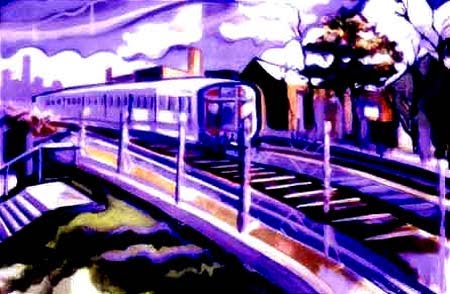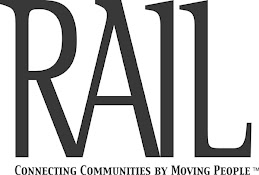Late last year, we discussed the growing importance of the Detroit – Chicago Corridor in Michigan as a pragmatic advance in higher-speed passenger rail in the North America (read the full post here for details). Since that time, a few other developments have emerged that should boost the confidence of high-speed and intercity passenger rail proponents.
The more surprising news is Thursday's announcement by the owners of the Florida East Coast Railway (FEC) – Florida East Coast Industries (FECI) – that they plan to institute frequent passenger rail service between Miami and Orlando by 2014. The plan follows the messy 2010 abandonment of the publicly-funded Florida High Speed Rail project's initial phase between Tampa and Orlando, which we discussed at length here. That FECI is so eager in its attempt to resuscitate the scuttled intercity rail effort in its home state suggests that high-speed rail supporters' claims that private investment to support the earlier project would easily materialize was correct. As FECI's promotional materials for the project – which they dub All Aboard Florida – note, they believe there will be healthy returns on their investment supported by the operation of frequent and reliable passenger rail service between Florida's largest metropolitan regions.
FECI believes it will be able to meet its 2014 scheduled service launch because the trains will operate over FEC's main freight rail corridor, which stretches from Jacksonville to Miami. The railroad was constructed on the state's east coast in the 1880's and has been in continual service as a freight line since then (passenger service was discontinued in 1968). The All Aboard Florida effort would construct 40 miles of new railroad between Cocoa and Orlando to create a 240-mile passenger route that would make the trip in three hours at speeds reaching 110 mph and averaging 80 mph. According to project materials, the service would operate with the high levels of frequency necessary to sustain demand for a vibrant intercity rail corridor and utilize conventional equipment, likely diesel locomotives hauling passenger coaches. Whether the rolling stock would be new or rehabilitated has not yet been released. Should the Miami – Orlando operation prove to be successful, FECI plans to expand the service to Tampa and Jacksonville, although details on those extensions are premature at this stage.
In addition to the positive operating revenues that are likely at the foundation of FECI's belief in the vitality of the project, additional nuances inherent in the FEC's modern operating environment make the effort even more understandable. Initially, the FEC is the first large railroad – either Class I or Class II, of which FEC is categorized as the latter – to fully utilize positive train control (PTC). FEC instituted PTC after a fatal 1987 collision. Already, the railroad operates its freight trains at speeds of up to 60 mph, among the highest in the industry. As a result, allowing passenger trains operating over the non-PTC speed limit of 79 mph is already possible on the line. Additionally, the FEC has likely realized the full freight potential of its railroad, with recently-completed cargo port facilities in South Florida representing the largest mechanism to grow freight traffic on the corridor. Accordingly, integrating passenger service into its portfolio of revenue-producing products marks an additional opportunity to utilize the full capacity of the railroad. Lastly, FECI is already well-staged to benefit from the developments fueled by a thriving intercity passenger rail operation, as the entity already has land development enterprises established to maximize the value of the land of and around its rail line. Having that organizational capability already established leaves FECI in a prime position to deploy rail-oriented development around the operation's stations.
Less a shocking development – but no less important, and perhaps much more so – is the turn-around in progress on California's High-Speed Rail network. Although the project has already lined-up far greater investment – $2.25 billion in federal funds through the American Recovery and Reinvestment Act and $9.95 billion from state proposition 1A in 2008 – much of 2011 saw misgivings at best and backlash at worst towards the initiative, which would connect San Francisco to Los Angeles with new, world-class high-speed rail infrastructure at speeds up to 220 mph and a trip time of 2 and 1/2 hours. Additional branches would expand the system to Sacramento and San Diego.
The turn of favor against the project was fueled, in part, by the release last November of the project's Business Plan, which estimated project costs skyrocketing from $40 billion in 2008 to more than $90 billion. The Business Plan did correctly note, however, that it calculated that cost by expected rates of inflation by 2040, when the full network is scheduled for completion, as well as the costs of a longer timeframe. As those details emerged, high-speed rail opponents found new ammunition against the entire project, and threatened to abandon the entire effort. But, in his 2012 State of the State speech, Governor Jerry Brown reaffirmed his administration's commitment to the project and promised to conduct a thorough re-assessment of the plans in order to reduce costs and shorten the timeframe.
To that end, Brown appointed Dan Richard – a former member of the Board of Directors of the Bay Area Rapid Transit (BART) system – as Chairman of the California High-Speed Rail Authority, and tasked him with re-establishing the vitality of the project. In working with the State Legislature, local leaders and project officials, the Authority has been able to re-cast the project to include new improvements to existing passenger rail infrastructure in both the Northern and Southern California metropolitan regions while still commencing construction of high-speed infrastructure in the state's Central Valley. The shift is expected to satisfy enough of the political unrest surrounding the project to allow the Legislature to approve release of Proposition 1A funds, and will mark significant upgrades to commuter rail operations between San Francisco and San Jose on the Caltrain service – which will be electrified under the effort – and Metrolink's Antelope Valley route between Lancaster and Los Angeles. Both segments will be enhanced to support blended high-speed and commuter rail operations, although not necessarily allow the very high speeds or higher frequencies stipulated in the full high-speed rail plan due to two, rather than four-track infrastructure and other capacity upgrades.
Nonetheless, the pragmatic compromise is the right move for the project as a whole. A delay or abandonment of the effort would be a massive setback to high-speed rail efforts in the nation, while also exacerbating traffic congestion on California's highways and air facilities. As the project advances, it will serve as a test case for high-speed rail technology, as the millions of annual visitors to the state can witness a true high-speed operation in reality. In the meantime, commuters and travelers in California's largest metropolitan regions will benefit from greatly enhanced commuter rail service and tens of thousands of both permanent and temporary construction jobs will be created to build those segments and the high-speed route through the Central Valley.
In all, the projects in Michigan, Florida and California – along with more gradually-improving conventional corridors in Illinois, the Pacific Northwest and Southeast – provide concrete evidence that the demise of high-speed and intercity rail projects that many observers predicted only a few months ago were short-sighted.
*Some observant readers may have noticed the title of this post as a reference to the H.O.R.D.E. Festival – Horizons of Rock Developing Everywhere – an annual summertime rock tour in the 1990s created by Blues Traveler.
Sunday, March 25, 2012
Subscribe to:
Comments (Atom)






